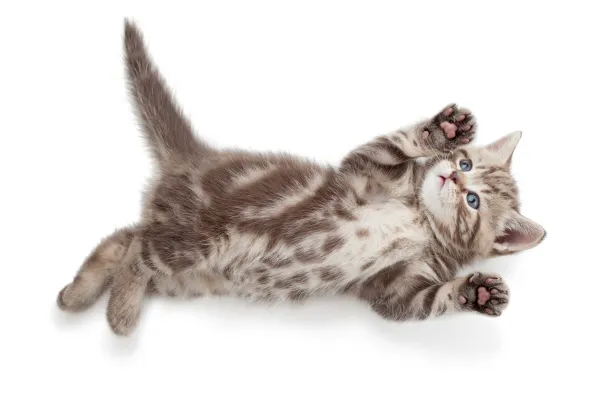How many fingers do cats have?
Our small cats generally have a specific number of toes between all their legs. As long as they keep all four legs and have not been victims of finger fractures or amputations, our feline companions have a total of 18 fingers made up of phalanges, which also contain their great defensive weapon that we all know: nails. However, it is not uncommon for some cats to have a greater number of fingers than normal, which is known as polydactyly and is more frequent in certain families or breeds of cats such as the Maine coon, pixie bob and ragamuffin.

How many fingers does a cat have?
Our small cats usually have a total of 18 toes between all their legs , but did you know that cats do not have the same front legs as their hind legs? Specifically, they have 5 toes on each of the front legs , while they have 4 on each of the hind legs., as long as they do not present any genetic mutation from birth that causes them to contain a greater number of fingers than normal. This condition, called polydactyly, generally doesn’t pose any risk to cats born with it beyond making them more peculiar. Therefore, if you have never done it before, we invite you to start counting how many fingers your cat has. Of course, generally they will not let you touch them because they consider them a very sensitive area that they must protect, since they contain their main defensive weapon, that is, their nails, so try to do it from a distance or using positive reinforcement.
As a curiosity, thanks to a study from Ireland carried out in 2018, did you know that cats do not use all their fingers equally? Some use them more than others because, like us, our little cats tend to be right-handed or left-handed , depending on whether they use one paw or the other more; generally the males have more predilection for the left leg, while the females seem to have it for the right leg.
What are cats’ fingers like?
Cat’s fingers are structures made up of phalanges , specifically, the proximal phalanx, the middle phalanx, and the distal phalanx. They are all articulated with each other by synovial joints. The distal phalanx is the one that contains the claws or nails, a retractile and flattened component that consists of a modified layer of the epidermis.
How many nails does a cat have? The same as fingers: 18. The distal end of the phalanx that contains the nail , that is, the last phalanx of the cat’s finger, contains:
- The nail process or process , which is a curved projection found within the horny claw.
- The nail crest , which is circumscribed to the base of the distal phalanx and serves for the insertion of tendons of the deep digital flexor muscle.
- Common digital extensor and lateral digital extensor of fingers 3, 4 and 5.
- The collateral ligaments and the dorsal ligaments.
In addition, claw retraction occurs with contraction of the dorsal elastic ligaments, of which there are two in each digit, attach to the dorsal surface of the nail crest, and originate on the lateral aspect to either side of the proximal extensor of the nail. middle phalanx. On the other hand, the claws extend when the deep digital flexor passes the elasticity of these ligaments.
In addition to the toes and nails, our cats’ paws end with padded-surfaced pulpy appendages called » pads » on the underside. Thanks to their nerve endings, cats can detect changes, temperatures and textures where they walk, but they can also be damaged or affected by diseases such as pododermatitis and sensitivity decreases over the years as they grow thicker. Another curiosity is that the pads usually match the color of the coat, being pink in cats with pale or white tones, while they appear dark in tabby, black or spotted cats or combinations.
What if my cat has 6 fingers?
As we mentioned in the first section, the most normal thing is for cats to have 18 fingers in total between all their legs, but some may have more fingers due to genetic mutations . This anomaly is known as polydactyly, hyperdactyly or hexadactyly and generally affects the front legs, although the hind legs do not have to be exempt. There are two types of polydactyly in cats:
- Preaxial polydactyly , in which the extra finger is the one next to the thumb, being well formed and equally developed.
- Postaxial polydactyly , where the extra finger is next to the little finger, being less developed.
This condition is autosomal dominantly inherited , which means that if a cat has 6 toes on one paw, half or more of its kits are likely to be born with this condition . This seems to be more common in certain breeds of cats, such as the Maine coon , ragamuffin , and pixie bob . In addition, it is more common in the American continent than in Europe. In other places like the United Kingdom these cats are called «cardi-cats». As a curious fact, the sailors of these places treated them as amulets, considering that they were better hunters of small prey because they had more fingers with which to attack them, which is why they used to carry them on their boats.
If you wonder if something happens because a cat presents polydactyly, the answer is no, not even when it is accompanied by radial hypoplasia. Radial hypoplasia consists in the fact that the radius bone of the front legs does not develop correctly, which makes the limb shorter and presents difficulties in movement, but not due to polydactyly, but due to insufficient development of this bone.
